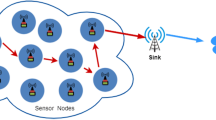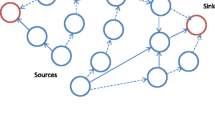Abstract
In order to extend the lifetime of a wireless sensor network, the energy consumption of individual sensor nodes need to be minimized. This can be achieved by minimizing the idle listening time with duty cycling mechanism and/or minimizing the number of communications per node. The nodes will have different relay loads for different routing strategies: therefore, the routing problem is important factor in minimization of the number of communications per node. In this paper, we investigate achievable network lifetime with a routing mechanism on top of an existing duty-cycling scheme. To this end, we formulated the routing problem for duty-cycling sensor network as a linear programming problem with the objective of maximizing the network lifetime. Using the developed linear programming formulation, we investigate the relationship between network lifetime and duty-cycling parameter for different data generation rates and determine the minimum duty-cycling parameter that meets the application requirements. To the best of our knowledge, this is the first mathematical programming formulation which addresses the maximum lifetime routing problem in duty-cycling sensor network. In order to illustrate the application of the analytical model, we solved the problem for different parameter settings.















Similar content being viewed by others
References
Blough, D. M., & Santi, P. (2002). Investigating upper bounds on network lifetime extension for cell-based energy conservation techniques in stationary ad hoc networks. In Proceedings of 8th annual international conference on mobile computing and networking (MobiCom) (pp. 183–192).
Chang, J.-H., & Tassiulas, L. (2004). Maximum lifetime routing in wireless sensor networks. IEEE/ACM Transactions on Networking (TON), 12(4), 609–619.
Cheng, M., Gong, X., & Cai, L. (July 2009). Joint routing and link rate allocation under bandwidth and energy constraints in sensor networks. IEEE Transaction on, Wireless Communications, 8(7), 3770–3779.
Chipcon AS SmartRF CC2420 Preliminary Datasheet (rev 1.2), 2004–06-09.
Dagher, J. C., Marcellin, M. W., & Neifeld, M. A. (February 2007). A theory for maximizing the lifetime of sensor networks. IEEE Transaction on Communications, 55(2), 323–332.
Ergen, S. C., & Varaiya, P. (2007). Energy efficient routing with delay guarantee for sensor networks. Wireless Networks, 13, 679–690.
Hou, Y. T., Shi, Y., Pan, J., & Midkiff, S. F. (2006). Maximizing the lifetime of wireless sensor networks through optimal single-session flow routing. IEEE Transactions on Mobile Computing, 5(9), 1255–1266.
Madan, R., & Lall, S. (August 2006). Distributed algorithms for maximum lifetime routing in wireless sensor networks. IEEE Transaction on Wireless Communications, 5(8), 2185–2193.
Mallinson, M., Drane, P., & Hussain, S. (2007). Discrete radio power level consumption model in wireless sensor networks. In IEEE Internatonal Conference on Mobile Adhoc and Sensor Systems (pp. 1–6).
Nama, H., Chiang, M., & Mandayam, N. (2006). Optimal utility-lifetime trade-off in self-regulating wireless sensor networks: a distributed approach. In Proceedings of the 40th annual conference on information sciences and systems (pp. 789–794).
Nash, S. G., & Sofer, A. (1996). Linear and nonlinear programming. New York: McGraw Hill.
Park, J., & Sahni, S. (2006). An online heuristic for maximum lifetime routing in wireless sensor networks. IEEE Transactions on Computers, 55(8), 1048–1056.
Shah-Mansouri, V., & Wong, V. W. S. (2007). Distributed maximum lifetime routing in wireless sensor networks based on regularization, Globecom, 598–603.
Singh, S., Woo, M., & Raghavendra, C. S. (1998). Power-aware routing in mobile ad hoc networks. In Proceedings of ACM/IEEE international conference on mobile computing and networking (MOBICOM), 181–190.
Toh, C.-K. (2001). Maximum battery life routing to support ubiquitous mobile computing in wireless ad hoc networks. IEEE Communication Magazine, 39(6), 138–147.
Wang, C.-F., Ding, J.-W., & Lee, C.-C. (2009). Joint optimization of energy allocation and routing problems in wireless sensor networks. Wireless Communication and Mobile Computing.
Xu, Y., Heidemann, J., & Estrin, D. (2001). Geography-informed energy conservation for ad hoc routing. In Proceedings of ACM Mobicom (pp. 70–84).
Author information
Authors and Affiliations
Corresponding author
Rights and permissions
About this article
Cite this article
Kartal Çetin, B., Prasad, N.R. & Prasad, R. Maximum Lifetime Routing Problem in Duty-Cycling Sensor Networks. Wireless Pers Commun 72, 101–119 (2013). https://doi.org/10.1007/s11277-013-1003-5
Published:
Issue Date:
DOI: https://doi.org/10.1007/s11277-013-1003-5




